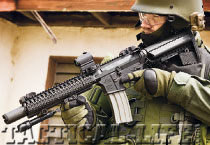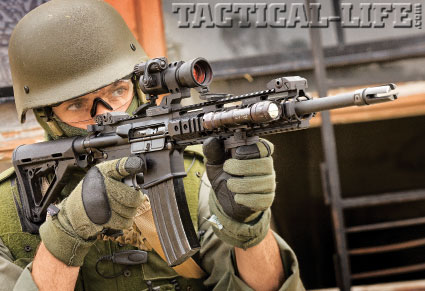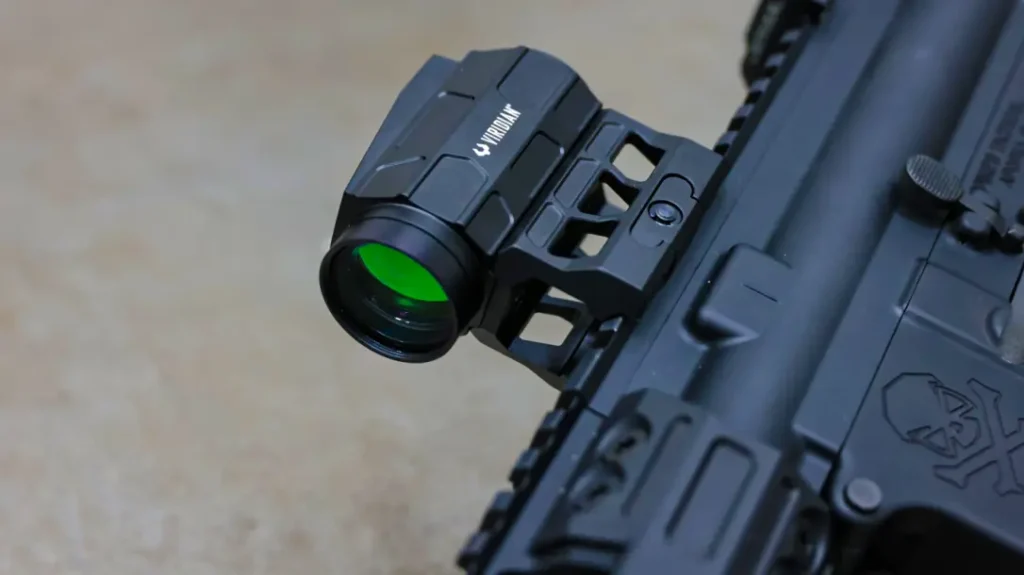This experience begins when a friend of mine, a defense contractor, returned home after serving nine months in Iraq as a personal protection specialist. We planned to get together to catch up and throw some lead downrange. Meeting up at a private indoor range, I agreed to come up with ammo and he was responsible for the guns. The curious thing was that he only brought one, a new Noveske Rifleworks N4 Light Shorty.
“I’ve already short barreled it. I ordered it before I deployed. I always wanted to own a 10.5-inch carbine like the one I carry in Iraq,” he said.
 Pointing to the cylindrical object attached to the muzzle, I asked, “Is that flash suppressor effective?”
Pointing to the cylindrical object attached to the muzzle, I asked, “Is that flash suppressor effective?”
Advertisement — Continue Reading Below
He didn’t respond but walked over to the switchboard and dimmed the range lights, leaving one to silhouette the target. With a P-Mag of just 20 rounds, he tapped, racked, flipped the selector before dancing his finger on the trigger and sending a fresh box of American Eagle ammunition to the silhouette’s chest. Beams of light shot out from the impressive group of holes carried by the smoke that filled the air. The flash I normally see out of a SBR (short barrel rifle) was, for the most part, absent. The device is Noveske’s KX3 flash suppressor and it has an unusual pair of notches where a strand of wire can be positioned to assure a round will cut it. As effective as the “Pig” was at killing flash, Cameron Hopkins later brought it to my attention that there was more to it. “Even though Noveske describes it as a ‘flash suppressor,’ it’s really more of a blast deflector. If you’ve ever shot next to [someone] with a short barreled AR, you’ll appreciate its benefits!”
N4 Light Shorty Details
The Noveske N4 Light Shorty has a cold hammer forged, 10.5-inch, 1-in-7-inch twist barrel that is made to the US machine gun M249 barrel steel and chrome lining specifications. The unspoken match-grade tolerance in the barrel-making arena is 2/10ths of a 1000th concentricity, a uniformity of bore diameter from muzzle to breech that John Noveske requires in his barrel specifications. M249 SAW barrels are known for their “double chrome lining” required to extend the service life of machine gun barrels suffering from the heat created when firing a high volume for extended periods. This isn’t to suggest that Noveske chromes his barrels twice. Rather, they are chromed once to the thickness that is nearly twice that of other Mil-Spec AR-style rifles. Many people attest to the belief that stainless steel barrels are inherently more accurate than a standard steel barrel and for these shooters many N4s are fitted with them as well.
The N4 Light Shorty tested featured the Low Profile Upper, which is available separately. This configuration features a forged Vltor MUR (Modular Upper Receiver) with anti-rotational interface and a 9-inch railed handguard. Flip-up front and rear sights were included but an Aimpoint did the short work on that particular range day. For those preferring an A2-style front sight assembly, barrel lengths or handguard types, the N4 Light Carbine Series comes in a myriad of optional configurations.
Advertisement — Continue Reading Below
If you get to own a complete Noveske N4 with a Low Profile upper, one typically comes equipped with a Vltor carbine buttstock, a TangoDown pistol grip, an MP-tested bolt, Noveske flip-up front and rear sights, and a low-profile gas block that’s pinned to the barrel. As a symbol of Noveske’s quality control, the company logo is stamped on a complete rifle’s right side above the trigger pins where the upper and lower receivers meet.
Light Recce Upper Details
As soon as I got back to work from that initial range experience, I contacted Noveske Rifleworks and ordered my own. Preferring Noveske’s 16-inch version, I learned that the N4 Light Recce Low Profile rifle that I desired was backordered. I searched various outlets and couldn’t find one in stock. To my joy, Noveske called back and asked if I’d be interested in the just the upper. Sacrificing a lower in my inventory, I accepted.
The N4 Light Recce Low Profile upper features a 16.1-inch, cold hammer forged barrel with a 1-in-7-inch twist to stabilize the 5.56mm NATO round. The barrel features extended feed ramps, which aid in the upper’s reliability. The Mil-Spec phosphate finished barrel is MP HP (magnetic particle high pressure) tested with a mid-length gas system and no M203 notch. The bolt is also MP tested and shot peened and sits within an auto carrier with a staked carrier key. The upper receiver is the aforementioned forged Vltor MUR connected to an 11-inch free-floated quad-rail handguard. The low-profile gas block is offered some protection under the handguard and is pinned to the barrel. Atop the rails are Noveske-supplied flip-up front and rear sights. Doing the work of killing the flash is a Smith Enterprise Vortex combat proven by the Canadian Special Forces.
Advertisement — Continue Reading Below
U.S. ARMY SDM PROVEN
A few weeks after putting together the N4 Light Recce, I hadn’t done anything more than a barrel break-in when I received an invitation to participate in an eight-day 82nd Airborne SDM (Squad Designated Marksman) course at Fort Bragg, North Carolina. With the US Army picking up the bill for the training ammo, I was given an equipment list that required an M4-style carbine and combat optic.
Check out this article about the US Army Ranger School!
After a couple days in the classroom, Sfc. Brad Kennedy instructed soldiers, “Your M4 is a 3-MOA rifle… at best! Some of you have Aimpoints. Most of you have Trijicons. Many of you have had the same rifle for years on all of your deployments. Do you know your round count? When was the last time your barrel was replaced? I’m going to show you how to take that rifle and be confident making an effective shot past 500 yards. That’s your job as an SDM.” Knowing that I had a rifle capable of sub-MOA accuracy, I had no room for mistakes as a guest of the US Army.
Advertisement — Continue Reading Below
The first two days were spent learning how to shoot a 3×5-inch card with metallic sights. The shortcoming of the Noveske rear sight was quickly noticed by an SDM coach. Sfc. Kennedy loaned me a Knight’s Armament flip-up rear used by SDM soldiers. The problem with the Noveske was that it wasn’t adjustable for elevation. Taking shots out to 500 yards with iron sights, I would need that capability. Using nothing but M855 62-grain military ball all week, the Noveske attracted attention on the firing line after plotting sub-MOA groups at 100 yards. With one 3-inch black spotter covering the white 3×5-inch card, my coach called down to the range pit for a target confirmation. The pit boss reported back, “They’re all under that spotter sergeant.” As the crew sent the target back up, the black spotter fell off the target. A message followed indicating that the shots were touching and created a hole just larger than the marker’s plug.
By mid-day, all shooters had made the proper sight adjustments and knew how to compensate for wind, a much-needed skill to be effective against enemy personnel targets beyond 200 yards. The N4’s performance was recorded in a data book, impressing the instructors at the end of each day. Confirming with the soldiers marking the target 500 yards away, I had fired 3 out of 5 groups using metallic sights that measured between 4 and 5 inches with most rounds staying impacting within the 3×5-inch card.
A few days later, we qualified with the metallic sights and attached our optics. The Trijicon ACOG I was using woke me up. After going back to 500 yards with open sights, seeing the target with a 4-powered optic made pinpoint shooting simple. Shooting at 100 and 200 yards with the ACOG seemed as easy as throwing rocks at a target. The best group fired with the ACOG measured 0.68 of an inch at 100 yards of ideal conditions on the final day of qualification.
Advertisement — Continue Reading Below
Throughout the week, wind gusted and rain poured. Mornings distorted the target with fog and the afternoon sun changed the lighting conditions we had just become accustomed to. This wasn’t just a typical gun test in a controlled environment. This week proved to the soldiers and myself what the Noveske N4 delivers — accuracy and performance.
Parting Thought
The SDM instructors handled and groped the N4 Light Recce each evening in the barracks during the period allotted for weapon’s maintenance. “I can’t even begin to imagine how effective we’d be in combat if SDMs were equipped with a sub-MOA rifle like this,” noted Sfc. Kennedy. “I’ve never seen anything shoot like it.”
At the time of this writing, Noveske Rifleworks’ disclaimer reads, “Until we deliver on our current backorders, we are not taking any new orders. Check back for instock items.” This statement is a sign of a good investment if you’ve already managed to obtain one. Complete Noveske N4s have been on back-order long before the rush for “black rifles” began in late 2008. If you don’t have the time or patience, you might have an easier time obtaining a complete upper receiver assembly and upgrading a specific lower. There are opportunities to purchase a complete rifle from Noveske but if you don’t check back often, you may just miss a chance at owning one of the finest contemporary battle rifles.
Advertisement — Continue Reading Below























